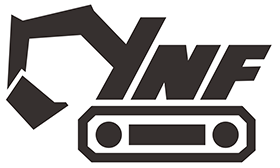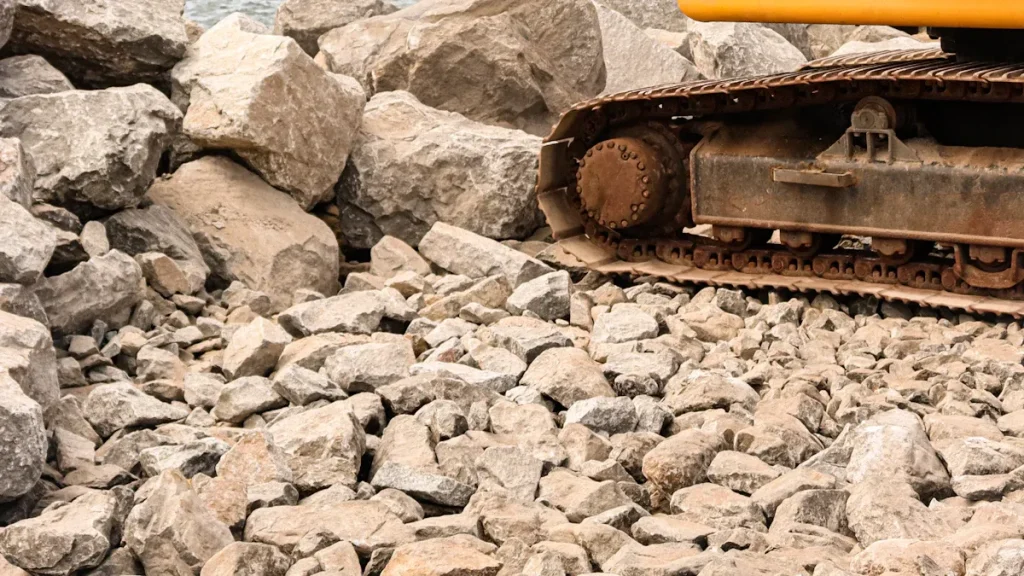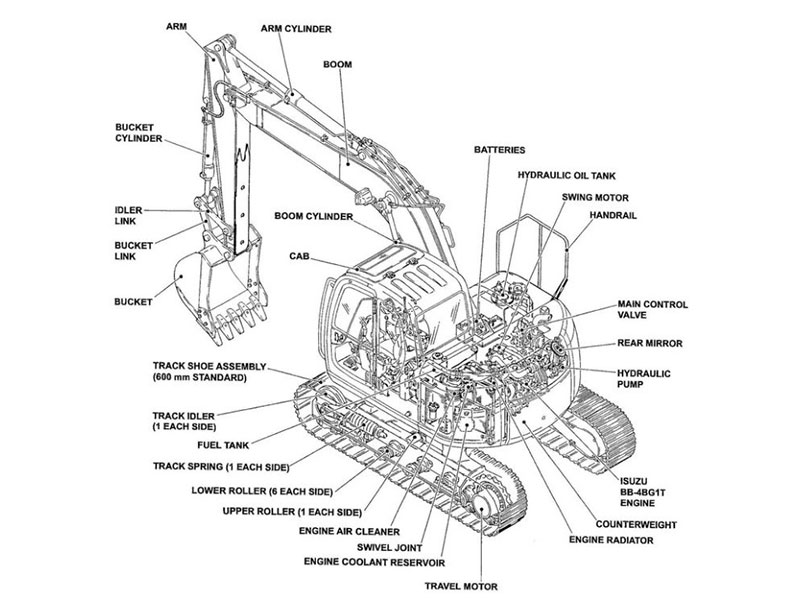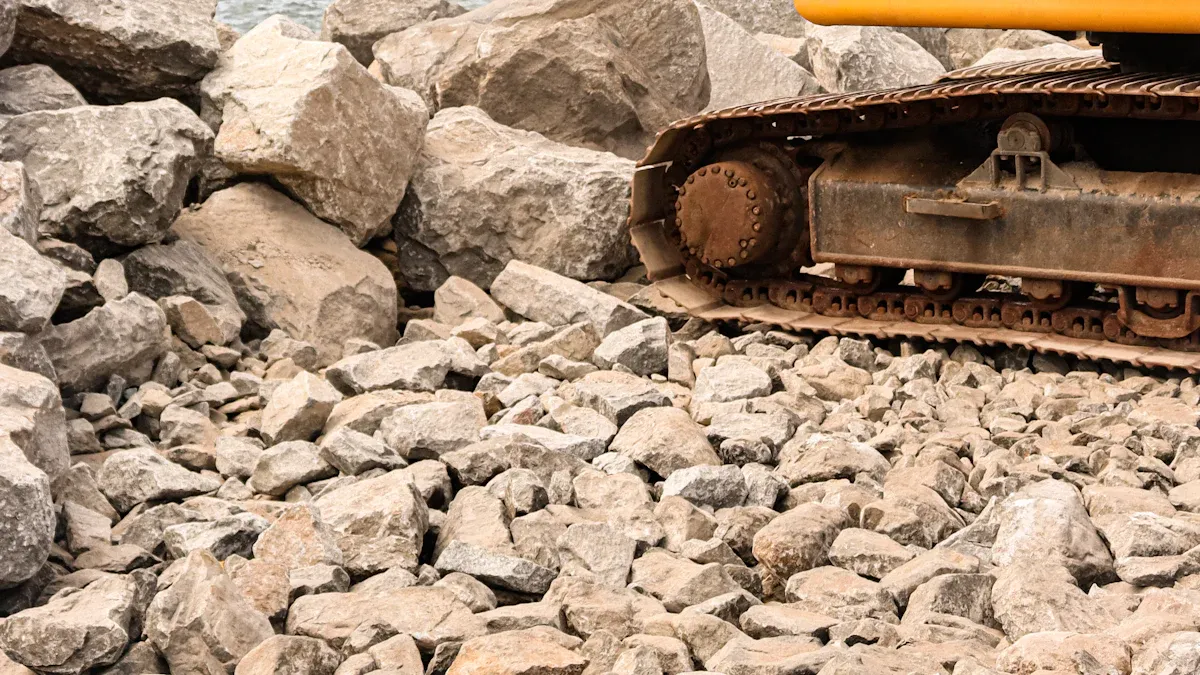
The main parts of an excavator each have a special job. The undercarriage holds up the machine and helps it move. The cab keeps the operator safe. The car body, or house, has the engine room and hydraulic system. The boom, arm, and bucket do the digging work. Linkage parts join these moving pieces. The counterweight keeps the excavator balanced. These earthmoving excavator parts work together for safe and good use. Knowing the important parts of an excavator helps people learn what they do and take care of the machine. Operators who learn about the parts of an excavator can make it safer and work better when using any excavator.
Key Takeaways
Excavators have main parts like the undercarriage, cab, car body, boom, arm, and bucket. These parts work together to dig, move things, and keep the machine steady.
You should check and take care of parts like tracks, hydraulic systems, and linkage every day. This keeps the excavator safe and helps it last longer.
The hydraulic system gives power to the boom, arm, and bucket. It is the most important part for smooth and strong moves.
Quick couplers help operators switch attachments quickly. This makes the excavator useful for many jobs and saves time.
Knowing about each part helps operators stay safe, find problems early, and spend less on repairs. This makes work faster and better.
Key Parts of an Excavator
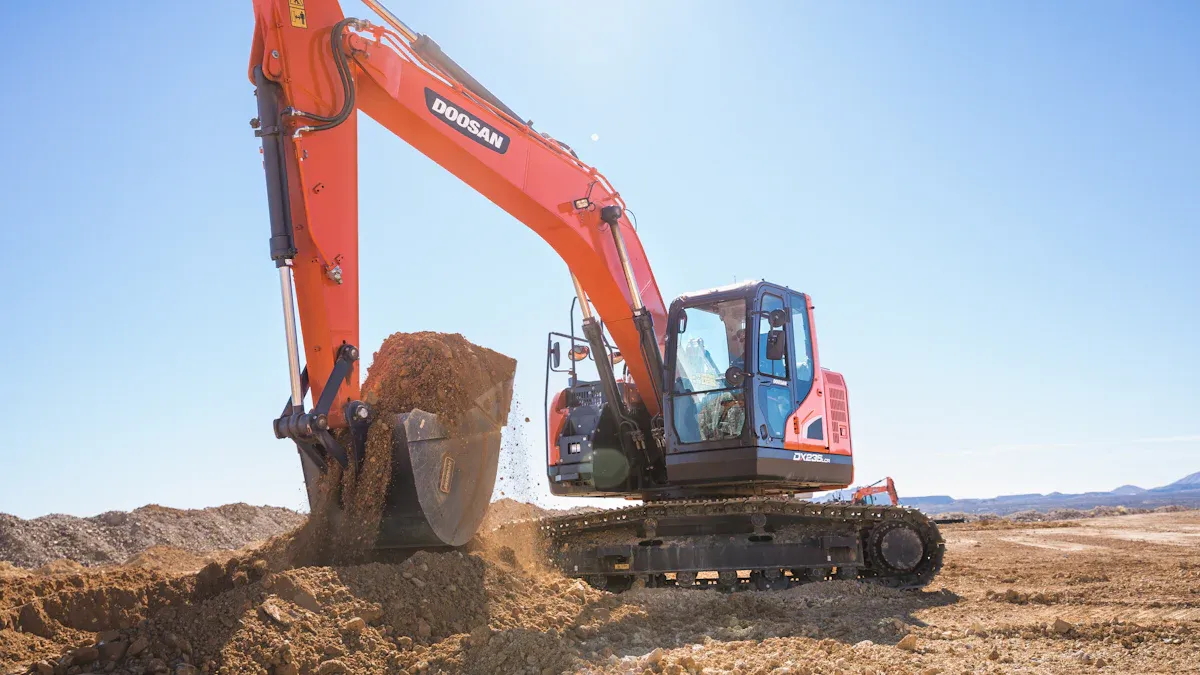
Excavators have a few main parts. Each part helps the machine stay steady, move, and work well. The undercarriage, cab, and car body all support the excavator. They help it do earthmoving jobs safely and quickly.
Undercarriage
The undercarriage is the bottom part of the excavator. It holds up the whole machine. It lets the excavator move on many surfaces. Most undercarriages use tracks, not wheels. Tracks help the excavator go over rough or muddy ground. Track chains are made from strong steel. This makes them last longer and handle hard work. The idler keeps the tracks tight. This helps the tracks wear out slower. The travel motor uses hydraulic pressure to turn the tracks. This moves the excavator forward or backward.
Tip: Check and clean the undercarriage every day. This stops damage and keeps the excavator working well. Add oil every 50 to 100 hours to stop friction and wear.
How long the undercarriage lasts depends on a few things:
The kind of work, like digging or pushing, puts stress on the undercarriage.
The ground, like hills or rocks, wears out the tracks faster.
How the operator drives also matters. Careful driving helps the undercarriage last longer.
Taking care of the undercarriage means checking the tracks, rollers, sprockets, and idlers. These parts must work together to keep the excavator steady and able to move. Good care keeps the excavator safe and helps it last longer.
Cab
The cab is where the operator sits and works. It is made to be safe and comfortable. The cab has big windows so the operator can see well. Many cabs have air conditioning and soundproofing. These help the operator stay awake and feel good during long jobs. The cab keeps out dust, noise, and bad weather.
Inside the cab, the operator uses controls to move the boom, arm, and bucket. The cab has safety features like seat belts and strong frames. These protect the operator if there is an accident. The cab’s design helps the operator work better and stay safe.
Car Body (House)
The car body, or house, sits on the undercarriage. It holds the engine, hydraulic system, and counterweight. The car body can spin all the way around. This lets the excavator dig and move things in any direction. A low center of gravity and strong frame keep the car body steady when lifting or digging.
Big companies say the car body has a strong frame and a zero tail design. These help the excavator lift better and make it easier to move. The car body connects the cab and undercarriage. It is a very important part of the excavator.
The undercarriage, cab, and car body all work together. They give the excavator balance, control, and movement. Real-life examples show these parts are important for jobs like loading, trenching, and grading. Watching these parts helps keep the excavator safe, working well, and easy to fix.
Earthmoving Excavator Parts: Front Attachment

Boom
The boom is a long and strong arm. It connects the car body to the front attachment. The boom lifts and moves the arm and bucket. It does this when digging, loading, or unloading. Engineers make the boom strong but not heavy. A good boom can last over 7,600 hours. This is more than what is usually needed. New booms use less material but still lift heavy things. Some new booms save energy. They can use up to 75% less power when lifting. These changes help the excavator work longer and use less fuel.
Arm (Stick)
The arm is also called the stick. It connects to the end of the boom. The arm reaches out and pulls back to move the bucket. The arm must be very strong. It handles a lot of force. Engineers test the arm with computers and real-life tests. These tests show the arm can lift heavy things and last a long time. The arm’s shape helps the excavator dig deep and reach far. Thick plates and strong welds stop the arm from bending or breaking.
Bucket
The bucket is the main tool for digging. It moves soil, rocks, or sand. The bucket attaches to the end of the arm. Buckets come in many sizes. They can be from 0.1 to 4 cubic meters. Big buckets move more dirt each time. This helps the job go faster. The table below shows how bucket size and cycles affect work:
Factor | Description | Impact on Worksite Efficiency |
|---|---|---|
Bucket Size | 0.1 to 4 cubic meters | Larger buckets move more per cycle |
Cycle Count | 30 cycles/hour for a 1-cubic-meter bucket | More cycles mean more material moved |
Operator Training | Skilled operators work faster and safer | Faster loading and unloading, less downtime |
A bucket that fits the job helps finish faster. It also saves effort.
Linkage Parts
Linkage parts join the boom, arm, and bucket. These parts are pins, bushings, and hydraulic cylinders. They are made from strong metals. This helps them last a long time, even with heavy loads. Hydraulic cylinders use fluid to make things move. This lets the excavator lift, dig, and move with care. Checking and caring for linkage parts keeps the machine safe. Sensors and controls help the operator move the parts smoothly. Good linkage design helps the excavator do hard jobs with less damage.
Tip: Check and change oil in linkage parts and hydraulic systems often. This stops breakdowns and keeps earthmoving excavator parts working well.
Excavator Parts: Hydraulic System and Engine Room
Hydraulic Cylinders
Hydraulic cylinders help move the boom, arm, and bucket. They use fluid under pressure to make strong, smooth moves. Good hydraulic fluid helps the cylinders work well. Checking the cylinders often stops leaks and damage. The size of the cylinder changes how fast and strong it moves. Some cylinders have more chambers to change force for different jobs. This makes the excavator work better. Sensors on the cylinders give live data. This helps with repairs and control.
Good hydraulic fluid helps cylinders work well.
Checking often stops leaks and heat problems.
Cylinder size changes speed and strength.
Sensors show when repairs are needed.
Hydraulic System
The hydraulic system gives power to most parts of the excavator. The engine sends power to pumps. These pumps move fluid through hoses and valves. The fluid moves the cylinders and other tools. New hydraulic systems use two pumps for more power and less fuel. Most energy from the pump goes right to the moving parts. This makes the excavator work well. New designs, like special rail networks and hybrid systems, help fluid move better and save energy. These changes help the excavator do hard jobs with less waste.
Note: Clean oil and new filters keep the system safe. This stops damage to excavator parts.
Engine Room
The engine room holds the engine, fuel tank, fluid tanks, and main valve. These parts work together to power and control the excavator. The engine makes energy for the pumps. The main valve sends fluid to the right cylinders for good moves. Sensors in the engine room watch for wear and help with repairs. The table below shows how long engine room parts last and what to look for:
Component | Typical Lifespan | Signs of Wear |
|---|---|---|
Engine Oil Filter | 250-500 hours | More engine noise |
Fuel Injectors | 1,500-4,000 hours | Misfires, rough running |
Pistons | >10,000 hours | Less compression |
5,000-10,000 hours | Overheating, leaks | |
Air Filters | 500-1,000 hours | Black smoke, bad fuel use |
Counterweight
The counterweight is at the back of the excavator. Its job is to keep the machine balanced when lifting heavy things. Without it, the excavator could tip over when digging or lifting. The size and weight of the counterweight match the excavator and its jobs. This part keeps the excavator safe and steady.
Tip: Always check that the counterweight is tight before work. A loose counterweight can cause accidents.
Excavator Machine Parts: Attachments and Versatility
Quick Coupler
A quick coupler is a special tool for the excavator. It lets workers change attachments fast. They do not need many hand tools. Many workers use quick couplers to save time. This also helps keep everyone safe. For example, a team in Denver used a strong quick coupler. They finished their bridge job early. They changed attachments in one minute instead of ten. This helped them avoid delays and get more jobs. Quick couplers also stop leaks in hydraulic lines. This keeps the worksite safe and clean.
Tip: Always check the quick coupler before you use it. Make sure it fits tight. This stops accidents and keeps the excavator working well.
Common Attachments
Excavator machine parts have many attachments for different jobs. Buckets dig and move dirt. Hammers break rocks or concrete. Grapples pick up logs or scrap. Augers drill holes for posts or trees. Each attachment is made for a special job. This makes the excavator more useful.
Operators want certain things when picking attachments:
They must fit many excavator models.
They should work for big or small jobs.
Some have custom settings for special work.
High pump capacity moves more material.
Strong cutter heads work on hard ground.
Hydraulic systems must match the excavator.
Tough materials last longer in hard jobs.
Controls are precise, sometimes with GPS.
Quick-release parts make maintenance easy.
Fast changes help the job go smoother.
The table below shows how hydraulic flow changes which attachment to use:
Hydraulic Flow Type | Best Attachment Match | Result |
|---|---|---|
High-flow | Heavy-duty attachments | More power, faster work |
Standard-flow | Light-duty attachments | Good for simple tasks |
Quick couplers let workers switch attachments fast. This means one excavator can do many jobs at once. These features make excavator machine parts very flexible and useful.
Knowing the main parts of an excavator helps people use it safely. These parts include the undercarriage, cab, boom, arm, bucket, hydraulic system, and engine room. When operators learn about these parts, they can do their jobs better. Taking care of the machine and using good parts makes it last longer. This also means fewer repairs and lower costs.
Operators who understand each part can find problems early.
Good care and keeping records help the machine work for more years.
Learning about excavator parts helps people work better and safer. It also helps save money. This knowledge gives anyone the skills to use, fix, or learn about excavators with confidence.
FAQ
What is the most important part of an excavator?
All parts are important, but the hydraulic system does most of the work. Without it, the boom, arm, and bucket will not move. Operators need strong hydraulics to dig safely and well.
How often should operators check excavator parts?
Operators need to check main parts every day. They look for leaks, loose bolts, and worn tracks. Checking often helps stop breakdowns and keeps the machine safe.
Tip: Doing a daily walk-around can find small issues before they turn into big repairs.
Can one excavator use different attachments?
Yes, many excavators have quick couplers. These let operators change buckets, hammers, or grapples in just a few minutes. This makes the machine useful for many jobs.
What causes the most wear on excavator tracks?
Rough ground, sharp turns, and heavy loads wear out tracks faster. Operators who drive slowly and stay away from rocks help tracks last longer.
Cause | Effect on Tracks |
|---|---|
Rocky ground | Faster wear |
Sharp turning | Uneven track damage |
Heavy loads | Increased stress |
